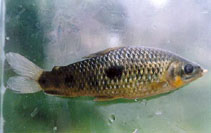| Family: |
Anostomidae (Headstanders) |
| Max. size: |
20 cm TL (male/unsexed); 25 cm (female); max.weight: 185.0 g; max.weight: 365.0 g |
| Environment: |
benthopelagic; freshwater; pH range: 5.5 - 7.5; dH range: 20 |
| Distribution: |
South America: Mana River basin. |
| Diagnosis: |
|
| Biology: |
Adults occur in large numbers at the entrance of creeks where the bottom is sandy or muddy and the current is fast or slow (Ref. 27188). Juveniles occur in calm, shallow waters, in counter current zones or in the shelter of plants (Ref. 12225). Omnivorous. They possess enzymes which enable them to digest chitin, pectin, hemicellulose and mucopolysaccharides. Individuals are easily captured with hook and line with small hooks (Ref. 27188). Reproduction takes place from December to June (Ref. 12225). Distinct pairs breed on densely grown weedy places (Ref. 205). Known among aquarists, this fish is considered turbulent in captivity (Ref. 27188). |
| IUCN Red List Status: |
Least Concern (LC); Date assessed: 19 June 2020 Ref. (130435)
|
| Threat to humans: |
harmless |
Source and more info: www.fishbase.org. For personal, classroom, and other internal use only. Not for publication.

